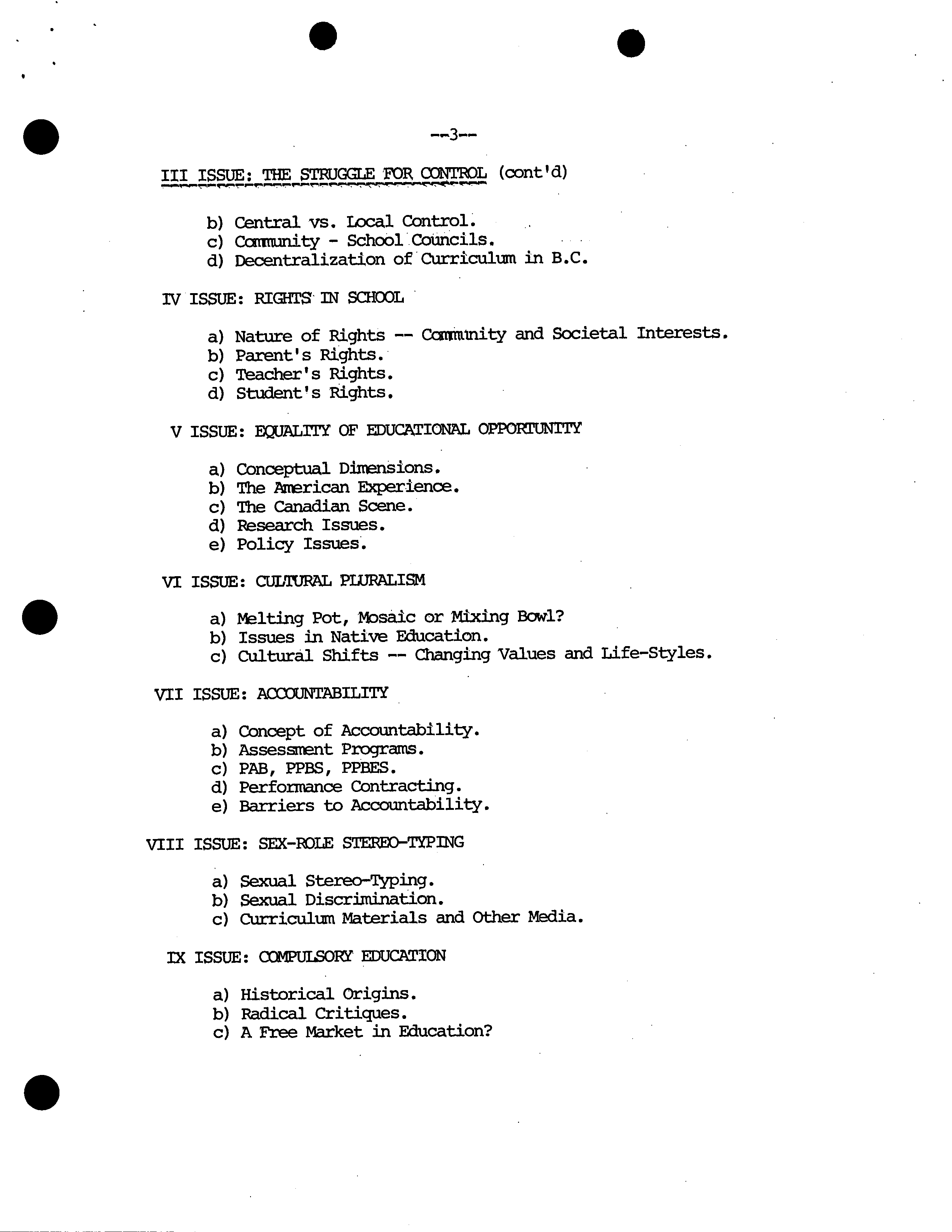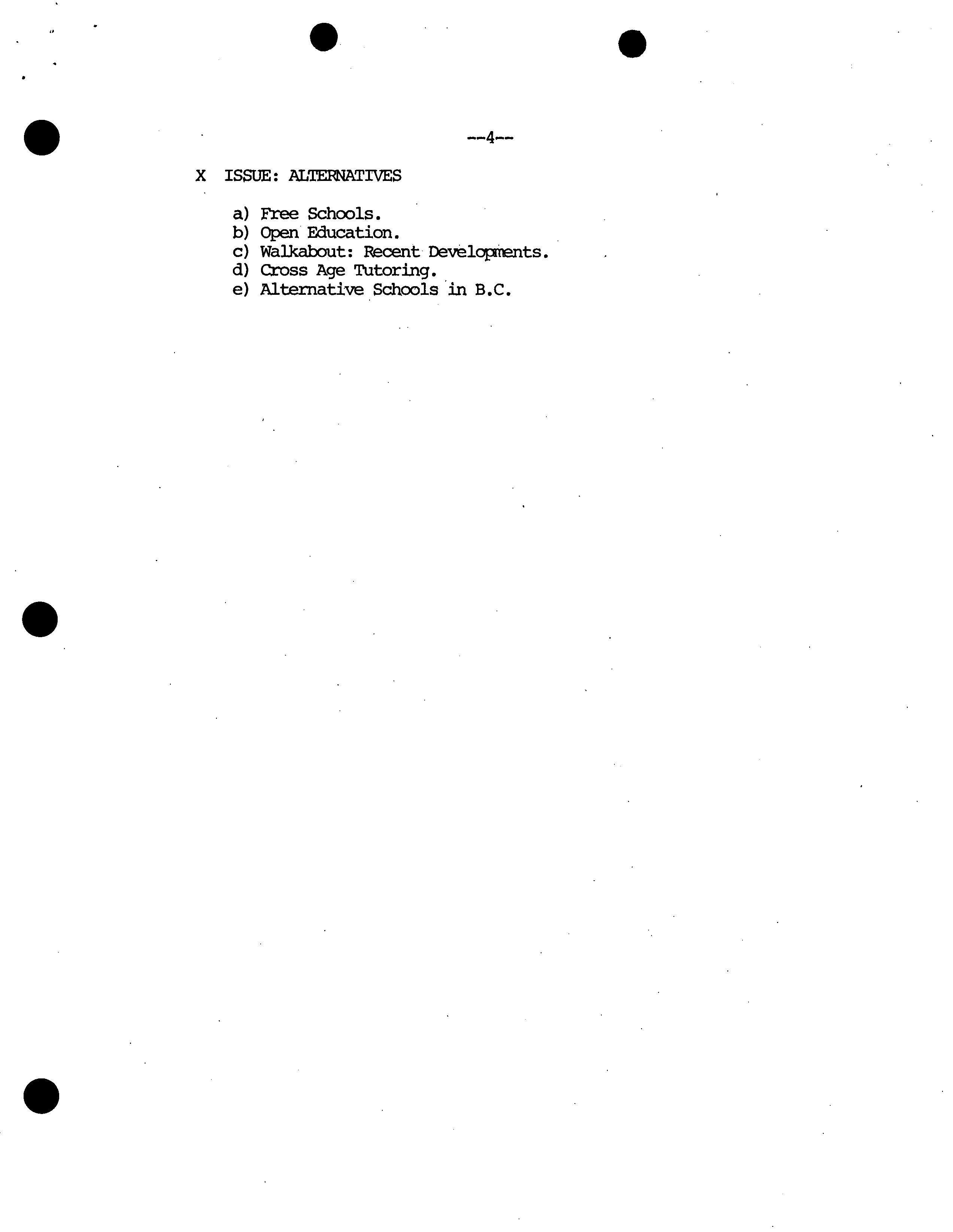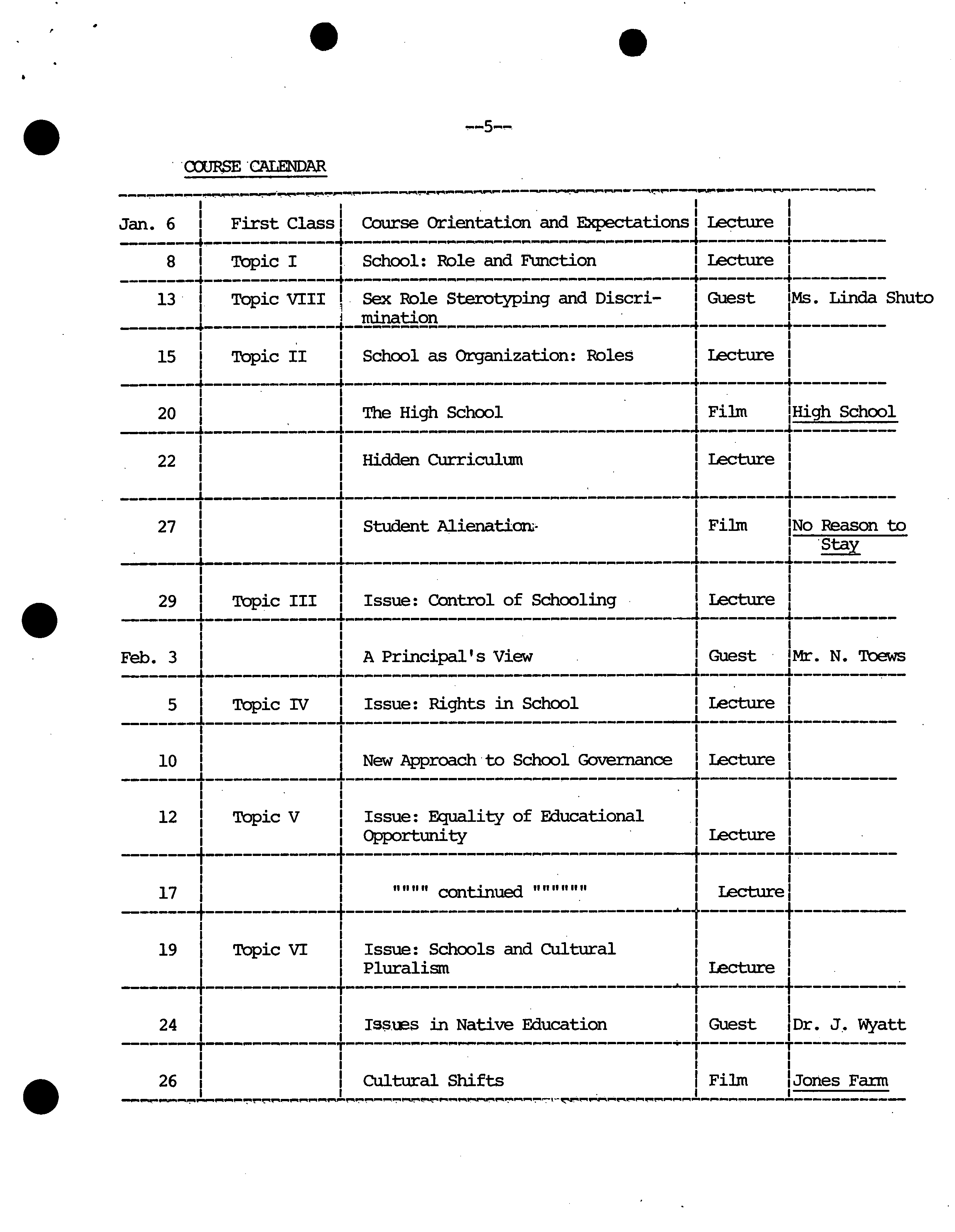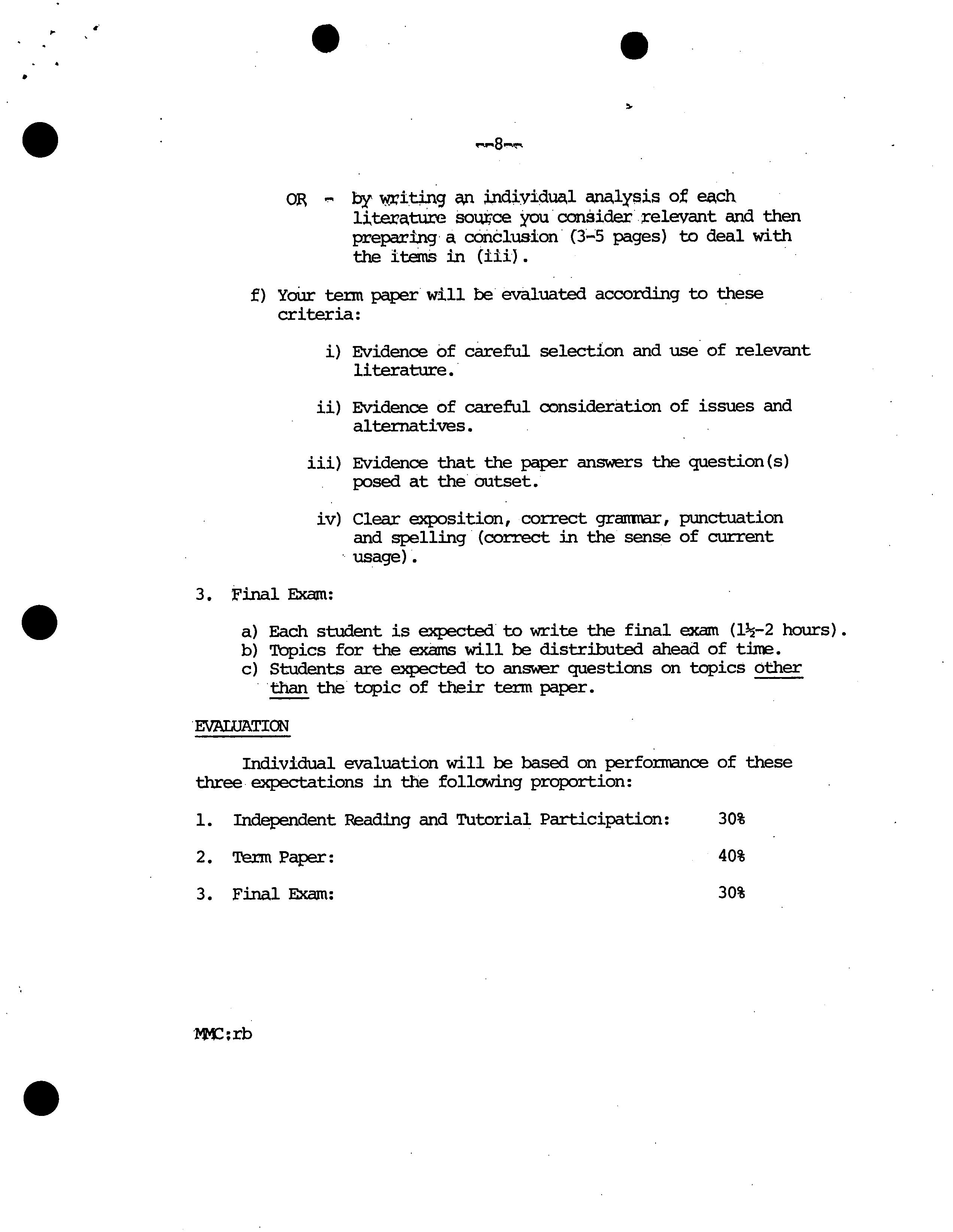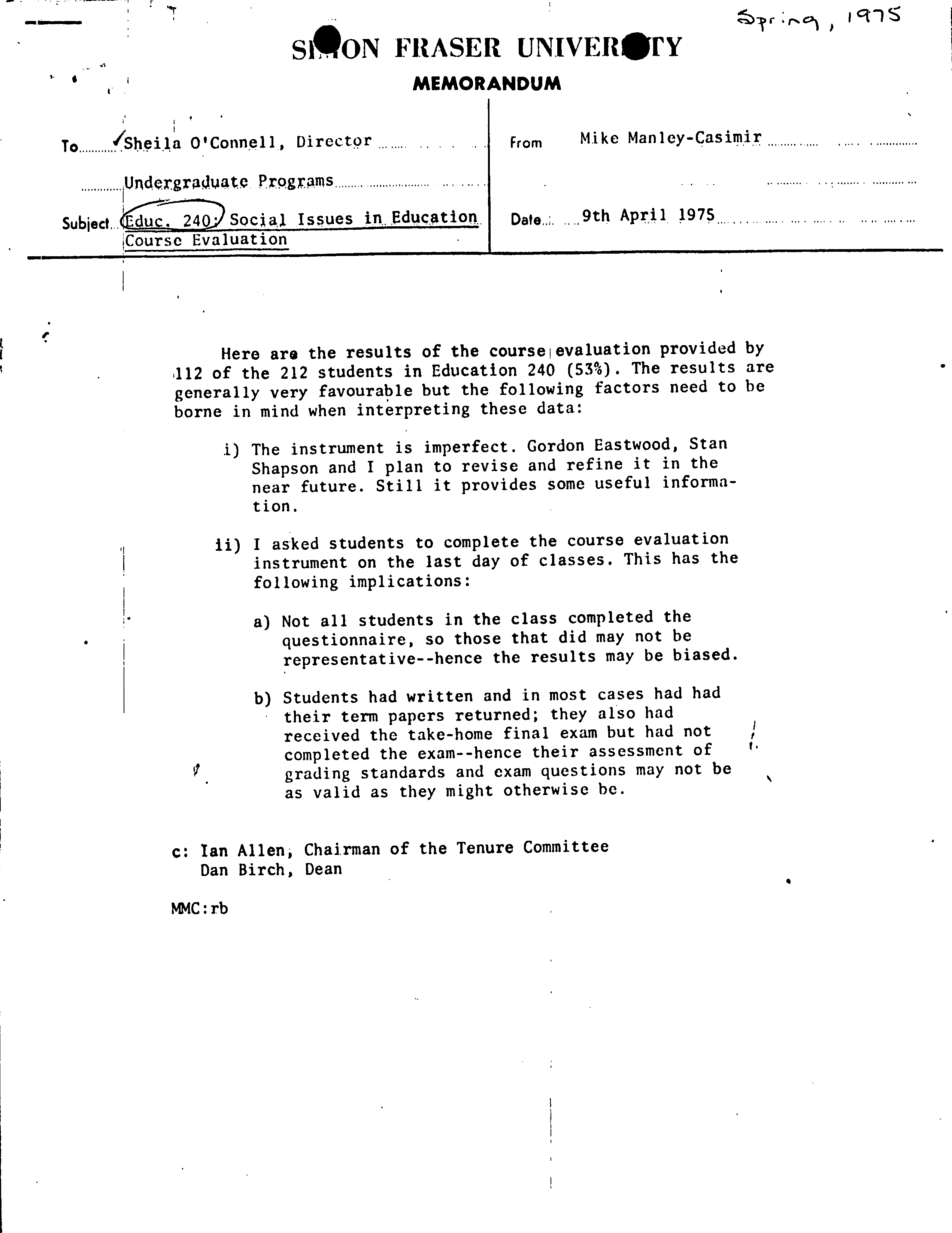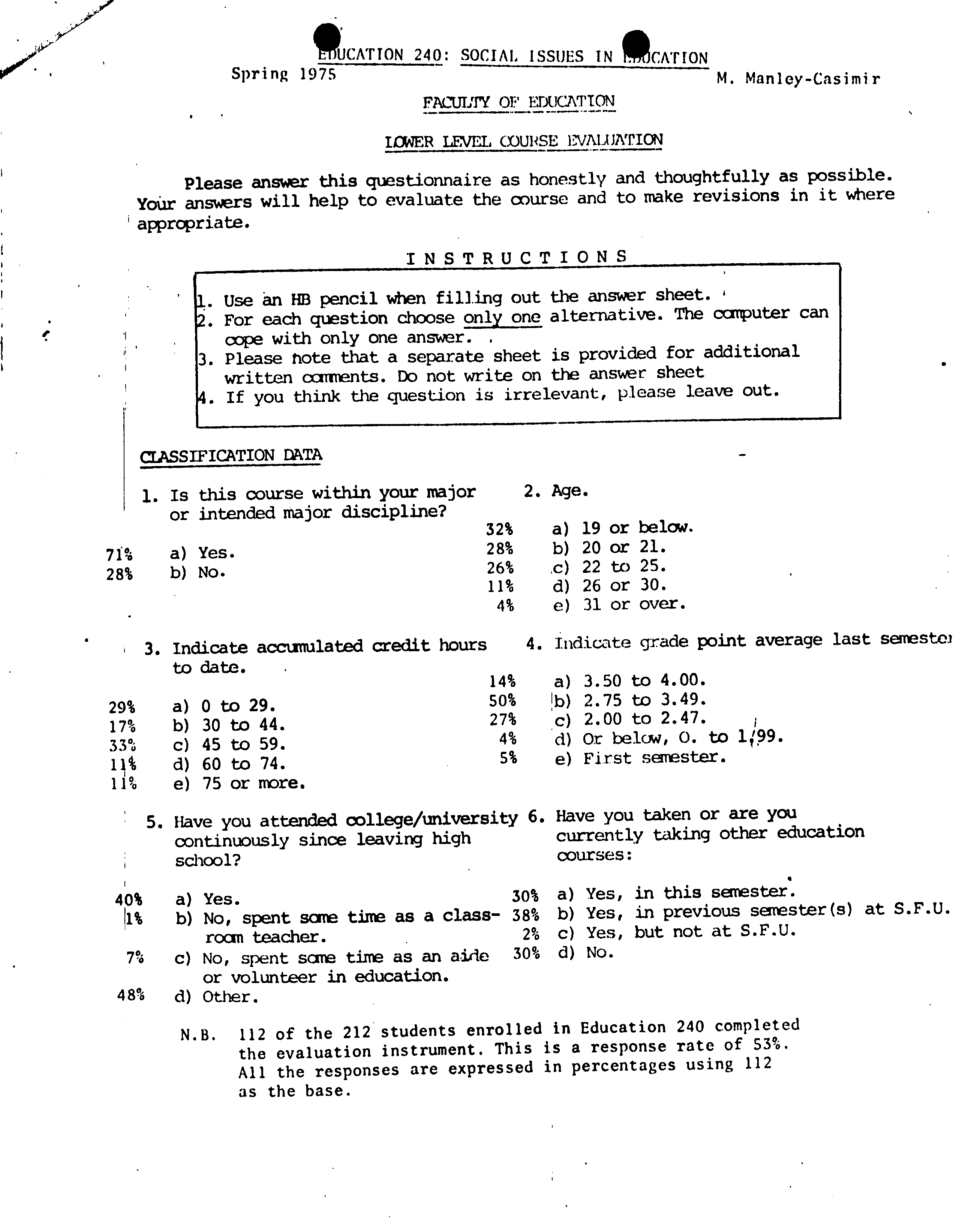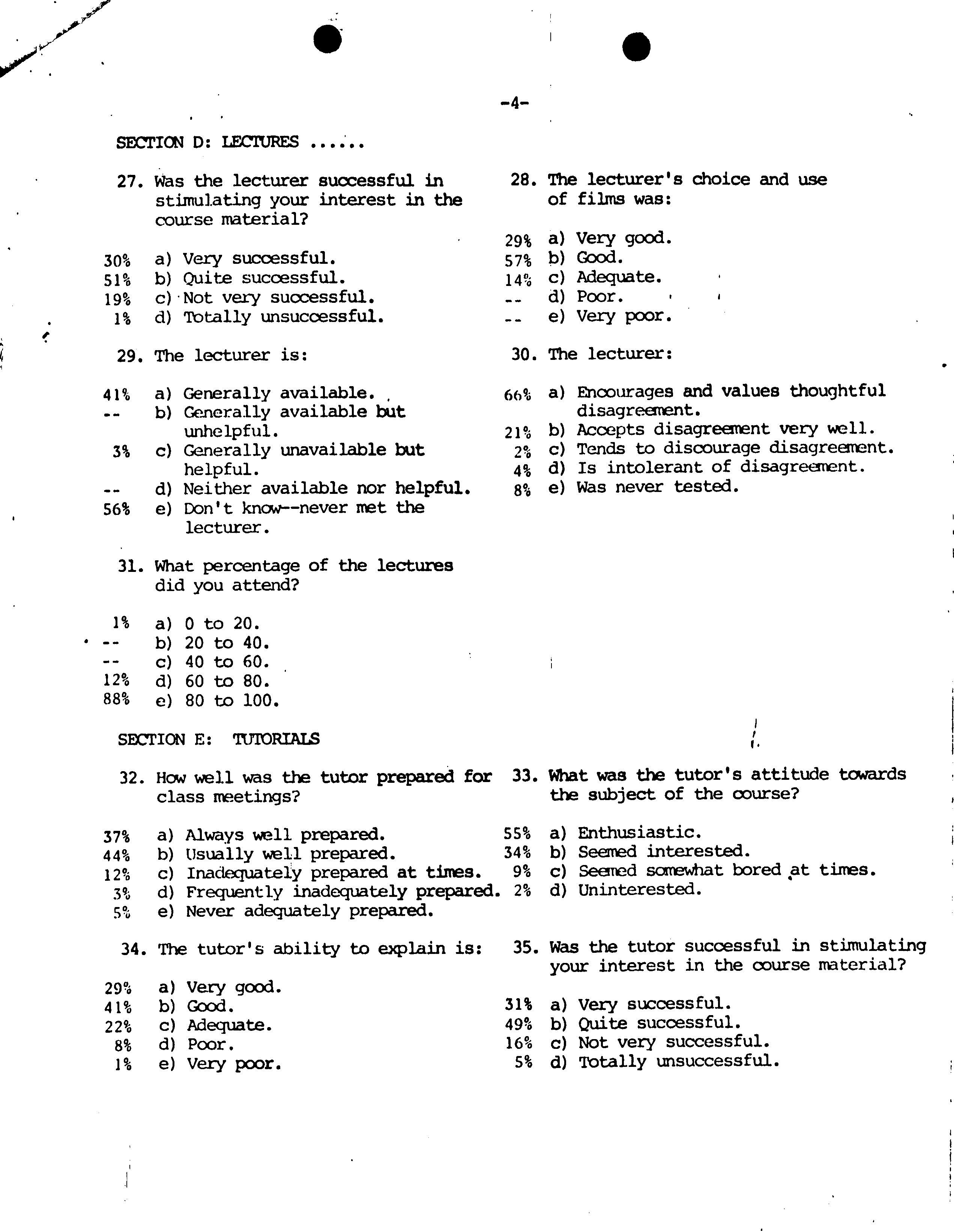.
?
.
COURSE $YT111BUS
Education 240 Sociai Issues in 'Education
?
Faculty of Education
Simon Fraser University
Spring 1975
Instructor: Mike Manley-Casimir
Roan 216, Building 2
? 94 Denman Court
Education Cczrlex ?
Coquit1, B, C.
Phone: 291-4387
?
525-3121
Lectures: ?
Monday and Wednesday ?
11:30-12:30 a.m.
January 6-April 4
?
AQ 9001
** ** * ** * * * **** * * * ** **** * * *
OBJECTIVE
The objective of this course is to provide students with an
understanding of the role and functions of the school as a social
institution and of the issues that impinge on (and often swirl
turbulently about) the school.
PLD OUS
.
?
?
More specifically, the course is designed to yield the following
learning outcczes:
Primary Instructional Modes
I mastery of a basic core of
knowledge about the realities
of schools as social institu-
tions -- their nature, organi-
zation, and functions.
ii general understanding of the
range and cariplexity of issues
impinging on the school.
iii detailed knowledge of a
selected issue gained from an
in-depth analysis.
iv ability to marshall relevant
knowledge in response to final
exam questions.
Four required texts.
Lectures, Films,
Guests and Tutorials.
Independent Reading
Term Paper.
Independent Reading
Final Eam.
Independent Reading
0
C
?
S
.
1JID TEXTS
Philip A. Cusick, Irside "High Schbol (New Yorke Holt, Rinehart
and Winst)
cn, l973) . Paperback.
'A. Richard King, 'The School at i'pass (New York: Holt, Rinehart
and Winston, 1967). Paperback.
Seur, Sarason, The 'Prob1n't 'of Change and the 'Culture of the
'School (New York: Allyn, 1971) Paperback.
Philip W. Jackson, Life 'In Cia.sroaris (New York: Holt, Rinehart
and Winston, 1968).
William Strunk and E.B. White, 'The ElarentS of Style (New York:
MacMillan, 1972). Paperback.
The first four texts will provide students with a common core
of knowledge and canon frames of reference. All students are expected
to beccm
thoroughly
familiar-with-each of these basic references.
The fifth book -- 'The 'E1tnt 'of Style-'i
.
S
specifically included for
. ?
those students who W)ThrOVe their writing style. It is not
a "required" text in the sàn sense as the others -- it is required
only
,
for those who need it. Still, it is a gem of a book -- well
worth 'reading, if not owning.
PLPJN 'OF 'TOPICS
I THE SCHOOL A1]) SOCIETYc ROLE AND FUNCTIONS
a)
Goals and Purposes.
b)
socialization, Stratification and Mobility.
c)
Conflicts in Public Expectations
II THE SCHOOL AS A SOCIAL INSTITUTION
a)
Formal Organization.
b)
The Role of the Principal.
c)
The B
p
le of the Teacher,
d)
The Role of the Student..,
e)
The Hidden Curriculum.
f)
Student Alienation.
III If3,SUEc THE STRUGGLE FOR CONTROL
a) Conflicting Claims for Control.
.
. ?
.
D
.
III ISSUE:
ISSUE: THE $T1JG(LE FOR CONTROL (oont'd)
b)
Central vs. Local Control.
c)
Ccxmtunity - School Councils.
d)
Decentralization of Curriculum in B.C.
IV ISSUE: RIGHTS
,
IN SCHOOL
a)
Nature of
Rights --
Cczmiunity and Societal Interests.
b)
Parent's
Rights.
c)
Teacher's Rights.
d)
Student's Rights.
V ISSUE:
EQUALITY OF EDUCATIONAL OPPOIUNITY
a)
Conceptual Dins ions.
b)
The Atirican Experience.
c)
The Canadian Scene.
d)
Research Issues.
e)
Policy Issues.
VI ISSUE: CULTURAL
PTIJRALISt4
a)
Melting Pot, Mosaic or Mixing Bowl?
b)
Issues in Native Education.
c)
Cultural Shifts -- Changing Values and Life-Styles.
VII ISSUE: ACCOUNTABILITY
a)
Concept of Accountability.
b)
Assessirent Programs.
c)
PAB, PPBS, PPBES.
d)
Performance Contracting.
e)
Barriers to Accountability.
VIII ISSUE: SEX-ROLE STEREO-TYPING
a)
Sexual Stereo-Typing.
b)
Sexual Discrimination.
c)
Curriculum Materials and Other Media.
IX ISSUE: (XIWUISOR? EDUCATION
a)
Historical Origins.
b)
Radical Critiques.
c)
A Free Market in Education?
40
S ?
.
--4--
X ISSUE: ALTERATIVES
a)
Free Schools.
b)
Open Education.
C)
Wa]Jabout: Recent Devëlcpients.
d)
Cross Age Tutoring.
e)
Alternative Schools in B.C.
.
0
.
?
.
. ?
--5--
• COURSE 'CALENDAR
_____•___,_J_.___-___-_-__-__-______-----------'----
------
??
Jan. 6
?
First Class Course Orientation and Expectations Lecture
?
8
?
Topic I
?
1.
School: Role and Function
?
Lecture
13 1 Tooic VIII I Sex Role Sterotyping and Discri- ?
Guest ?
Ms. Linda Shuto
mination
--
?
15
?
Topic II ?
School
as Organization: Roles
?
Lecture
--------------
4-
----------------------------------------------------------
?
20 ?
The High
School ?
Film
?
High School
----------------------------------------------------------------------t
-----------
?
22 ?
Hidden Curriculum ?
Lecture
?
27
?
Student Alienation-
?
I
Film
?
Reason to
?
29
?
Topic III
?
Issue: Control of Schooling ?
' Lecture
?
Feb. 3 ?
A Principal's View ?
Guest ?
Mr. N. Toews
?
5
?
Topic IV
?
Issue: Rights in
School ?
i
Lecture
?
10 ?
New Approach to School Governance Lecture
?
12 ?
Topic V ?
Issue: Equality of Educational
Opportunity ?
j Lecture
?
17 ?
" " " " c,crit.iritieci ?
, ""
?
I.ec'.xre
--
19
1 1
Topic
VI
I
Issue: Schools and Cultural
Pluralism
?
Lecture
- ---
-.--------
?
24
?
Iss ues in Native Education
?
-Guest iDr. J. Wyatt
?
26
?
Cultural Shifts ?
I
Film
?
IJones Earn
.
0
Mar. 3
Topic I
Conflicting Public Expectations
Debate 11 Dr. E. Cro
-
------
__ --------
----- ---.-------------
- ------
Dr. N. Daw
f-------
**
I
[EI4 P'ERS DUE THIS WEEK
Weds 5
Topic VII
Issue: Accountability
Lecture
10
Topic
IX
Issue: Ccztpilsoiy Education
Lecture
12
CaTipulsion: A Valid State Interest?
Guest
Dr. D. En
17
Topic X
Issue: Radical Debate and Alter-
natives
Lecture
----------
.----------------------------------------------
-------- ---
19
The Walkabout: Recent Developments
Guest. Dr. M. Gib
------------
--------------------------------------------
24
Cross Age Tutoring
Guest
Dr. A. Eli
26
UNASSIGNED
31
No class
EasterMonday:
Library Open
April
2
Last class
Recapitulation and Course Surrrnaxy
C
3e
Lnsky
Lott
S
0
?
ODURSE CALENDAR (cont' d)
Aril 17
-19
.... ...............E X A MS..........................................
C
S
U
S
ExPrNr'a'1S
1.. Independent Reading and Tutorial Participation:
The course combines lectures with tutorials and independent
reading. Each student is expected to attend lectures and
tutorials on a regular basis and to accept a major responsi-
bility for reading around the topics of lectures and tutorials.
All students are expected to participate actively in tutorials.
2. Term Paper -- Guidelines and Criteria:
a)
Each student is expected to write a term paper of between
10-12 double-spaced 8 x 11 typed pages either on one of the
topics discussed in the course or on a topic of your own
choice. In either case, your proposed paper must be approved
by your tutorial leader.
b)
Your paper should be handed in during the week of March 3
to your tutorial leader. It can be handed in earlier but not
later.
C)
Your paper should be based on your reading of at least two
S ?
books and five articles. (The latter may be from journals
or collections of readings).
d) Your paper should:
i)
Start by posing One central question which you plan to
answer. Subsidiary questions may also be posed and answered.
ii)
Identify the main elements of the question.
iii)
Discuss these elements systematically in terms of the
relevant literature. This discussion should:
-- relate the main points of each source to each other,
-- identify the major areas of agreement. and disagreement.
- identify suggestions -made to resolve disagreements.
-- indicate where you stand on the issue and the action
you would advocate for resolving the issue.
e) You may fulfill the requirement in (iii) above:
EITHER - by writing the more usual essay type paper in
which you integrate the sources in your argunnt.
S
S
?
.
.
.
'
writing avi individual analysis of each
literature soce you conider relevant and then
preparing
a
conclusion' (3-5 pages) to deal with
the its in (iii).
f) Your term paper will be evaluated according to these
criteria:
i)
Evidence of careful selection and use of relevant
literature.
ii)
Evidence of careful consideration of issues and
alternatives.
iii)
Evidence that the paper answers the question(s)
posed at the outset.
iv)
Clear exposition, correct grammar, punctuation
and spelling (correct in the sense of current
usage).
3. Final Exam:
a)
Each student is expected to write the final exam (l½-2 hours).
b)
Topics for the exams will be distributed ahead of time.
c)
Students are expected to answer questions on topics other
than the topic of their term paper.
EVALUATION
Individual evaluation will he based on performance of
these
three expectations in the following proportion:
1.
Independent Reading and Tutorial Participation:
?
30%
2.
Term Paper:
?
40%
3.
Final Exam:
?
30%
q 4
;
rb
0
icr)
SOON FRASER UNIVER•E'Y
?
MEMORANDUM
To ............ ' She ila O'Connell, Director
?
From ?
Mike Man ley-Casirnir
.Unegrathiat ?
E,rp .
gams ....... ... ..........
...... ...........
?
Issues in
.
Education.
?
Date..:. ....9th April 1975
?
.......................
Course Evaluation
Here are the results of the course!evaluation provided
by
112 of the 212 students in Education 240 (53%). The results
are
generally very favourable but the following factors need to
be
borne in mind when interpreting these data:
1) The instrument is imperfect. Gordon Eastwood, Stan
Shapson and I plan to revise and refine it in the
near future. Still it provides some useful informa-
tion.
I asked students to complete the course evaluation
instrument on the last day of classes. This has the
following implications:
a) Not all students in the class completed the
questionnaire, so those that did may not be
representative--hence the results may be biased.
b) Students had written and in most cases had had
their term papers returned; they also had
received the take-home final exam but had not
completed the exam--hence their assessment of
grading standards and exam questions may not be
as valid as they might otherwise be.
c: [an Allen, Chairman of the Tenure Committee
Dan Birch, Dean
MMC:rb
2. Age.
32%
a)
19
or
bel
ow
.
28%
b)
20
or
21.
26%
c)
22
to
25.
11%
d)
26
or
30.
4%
e)
31
or
over.
3. Indicate accunulated credit hours
to date.
4. Indicate grade point average last senstei
29%
a)
0to29.
17% b)
30
to 44.
33% c)
45
to 59.
11&
d)
60
to 74.
11
0
0
e)
75
or more.
14%
a)
3.50 to 4.00.
50%
b)
2.75 to 3.49.
27%
c)
2.00 to 2.47.
4%
d)
Or below, 0. to 1199.
5%
e)
First semester.
.>fr,
VT
OUCATION
240:
SOCIAL
ISSUES IN WAvON
Spring 1975
?
M. Manley-Casimir
!!'JIJ1
OF FDtKI\TION ?
LOWER LEVEL (X UI
?
13VALUNrION
Please answer this questionnaire as honestly and thoughtfully as possible.
Your answers will help to evaluate the course and to make revisions in it where
arcriate.
T N S 'P R 11 C T I 0 N S
• Use an HB pencil when filling out the answer sheet.
• For each question choose only one alternative. The caTiputer can
cope with only one answer.
• Please tiote that a separate sheet is provided for additional
written xmnts. Do not write on the answer sheet
• If you think the question is irrelevant, please leave out.
CLASSIFICATION DATA
1. Is this course within your major
?
or intended major discipline?
71's ?
a) Yes.
28% ?
b) No.
5. Have you attended
cxllege/university
6
• Have you taken
or are you
continuously since leaving high
?
currently taking other education
school?
?
courses:
a)
Yes. ?
30%
b)
No, spent sate time as a class- 38%
roan teacher. ?
S
?
2%
C) No, spent saffe time as an aide 30%
or volunteer in education.
d) Other.
a)
Yes, in this semester.
b)
Yes, in previous semester(s) at S.F.U.
c)
Yes, but not at S.F.U.
d)
No.
40%
11%
" 0.
I 0
48%
N.B. 112 of the 212 students enrolled In Education 240 completed
the evaluation instrument. This is a response rate of 53%.
All the responses are expressed in percentages using 112
as the base.
SECTION A: THE COURSE AS
A
WHOLE
7.
What was your principal reason
for
8.
The most enjoyable part of the
taking this course?
t
course was:
38
10
-
a) Required.
39%
a) Lectures.
35%
b) One of a group which must be chosen.
43%
b) Tutorials.
-
--
27%
-
d)
e)
C)
Fitted
Easy
Purely
credit.
nra'
optional.
schedule.
70,
3%8%
e)
d)
C)
Labs
Personal
Assignrrents'.
and field
consultation
work.
with
instructor.
9.
The overall organization of the course
10.
The course was:
was:
.
-2-
510 a) challenging.
74% b) Stimulating.
17% c) Average.
4% d) Uninteresting.
-- e) Boring.
46% a) Very well planned.
38% b) Well planned.
15% c) About right.
1% d) Saiwhat disorganized.
--
?
e) Far too disorganized.
11. What would you tell another student
if he asked whether or not he should
take this course?
13% a) Don't miss it.
67% b) it's a good course.
1(%
C)
It's adequate.
40
d) Take it only if you have to.
- ?
e) Avoid it.
13. The standards used in grading this
course ware:
12. Criteria for grading this course
ware:
93% a) Fair and clearly stated.
6% b) Unfair and clearly stated.
1% c) Not stated.
2% a) Very lenient.
7400
110
'
b)
C)
About
Scvwhat
right.
lenient.
10% d) Scmeihat strict.
4% e) Very strict.
SECTION B: READINGS AND WRITTEN WORK
D
14. The reading assignnnts ware:
25% a) Relevant and stimulating
32ç'
b) Relevant.
34
C)
Adequate.
5%
d)
Irrelevant.
3%
e)
Irrelevant and dull.
15. On the whole, the text (s) ware:
3%
a)
Essential.
31%
b) Useful.
34%
C)
Adequate.
20%
d)
Marginal.
13%
e)
Not useful at all.
-3-.
SECTICt,1 B: READINGS AND WRITTEN WORK
17. How much time spent each week reading
?
18. The
amount
of time spent on
for the course?
?
written work was:
31%
a)
0 to 1 hour.
--
a)
Far too little.
49%
b)
2
to 3 hours.
5%
b)
Somewhat too little.
18
0
0-
c)
4 or S hours.
88%
c)
About right.
1°
d)
6 or 7 hours.
5%
d)
Somewhat too much.
2°
e)
More than 7 hours.
3%
e)
Far too much.
19.
iici much freedom of choice In written
20.
Comments on your written work
assignments?
ware:
--
a)
Far too little.
31%
a) Very constructive.
5%
B)
Somewhat too little.
54%
b)
Somewhat constructive.
92%
c)
About right.
3%
c)
Never constructive.
3%
d)
Somewhat too much.
4%
d) Destructive.
--
e)
Far too much.
9%
e)
No comments at all.
SECTION
C: C:
EXAMINATIONS
21. The exam questions were oriented
toward:
8296
14%
b)
a)
Lectures
Lecture material.
and reading.
'° C)
Reading.
23.
How did exam questions test your
overall comprehension of the course?
2%
a) Not at all.
6% b) Very inadequately.
20%
C)
SciTlewhat inadequately.
71
0
0
d) Adequately.
SECTION D: LECTURES
24. HM
well was the instructor prepared
for his lectures?
84%
a) Always well prepared.
14% b) Usually well prepared.
1%
C)
Inadequately prepared at times.
1% d)
Frequently inadequately prepared.
- - e) Never prepared.
2. The lecturer's ability to explain
is:
450
a) Very good.
38% b) Good.
--
16%
?
d)
C)
Poor.
Adequate.
1% e)
Very poor.
22. H, about the clearness of
exam questions?
5% a) Vague and ambiguous.
31% b) Moderately clear.
39% c) Usually quite clear.
26%
d) Very clear.
25 • The lecturer's speaking ability is:
58%
a)
Very good.
31%
b)
Good.
8%
c)
Adequate.
2%
d)
Poor.
1%
e)
Very poor.
30%
51%
19%
1%
I.
29.
a)
Very successful.
b)
Quite successful.
c)
Not very successful.
d)
Totally unsuccessful.
The lecturer is:
-4-
SECTION D: LECTURES .....
27. Was the lecturer successful in
stimulating your interest in the
course material?
41% a) Generally available.
- - b) Generally available but
unhelpful.
3% c) Generally unavailable but
helpful.
- -
?
d) Neither available nor helpful.
56% e) Don't know--never met the
lecturer.
31. What percentage of the lectures
did you attend?
1% a)
0to20.
• ?
-- ?
b)
20to40.
-- ?
C)
40to60.
12%
?
d)
60
to 80.
88%
?
e)
80 to 100.
SECTION E: TUTORIALS
28. The lecturer's choice and use
of films was:
29% ?
a)
Very good.
57% ?
b)
Good.
14
0
0-
?
c)
Adequate
-
d)
Poor.
-- ?
e)
Very poor.
30. The lecturer:
66
9
6
a) Encourages and values thoughtful
disagreement.
21% b) Accepts disagreement very well.
2% c) Tends to discourage disagreenent.
4% d) Is intolerant of disagreement.
89
6
e) Was never tested.
32. How well was the tutor prepared for 33 • What was the tutor's attitude towards
class meetings? ?
the subject of the course?
37%
a)
Always well prepared.
55%
a)
Enthusiastic.
44%
b)
Usually well prepared.
34%
b)
Seemed interested.
12%
C)
Inadequately prepared at times.
9%
c)
Seemed sarewhat bored at times.
3%
d)
Frequently inadequately prepared.
2%
d)
Uninterested.
5%
e)
Never adequately prepared.
34. The tutor's ability to explain is: 35. Was the tutor successful in stimulating
your interest in the course material?
29
0
1
,
a) Very good.
41%
b)
Good.
31%
a)
Very successful.
22
9
.
c)
Adequate.
49%
b)
Quite successful.
8%
d)
Poor.
16%
c)
Not very successful.
1% e)
Very poor.
5%
d)
Totally unsuccessful.
000,0..
-5- ?
.
SECFI4 '
3: 'PJIORtALS
36. The tutor:
64% a) Encourages and values thoughtful
disagretnt.
23% b) Accepts disagreement very well.
4%
C)
Tends to discourage disagre€nt.
2% d) Is intolerant of disagre€nent.
7% e) Don 't know--was never
tested.
38. The tutor is:
37. For what purposes were the tutorials
primarily used?
16% a) To discuss lecture material.
4% b) To discuss material not related
to the course.
77% c) To discuss material not covered
by the lectures but related to
the course.
1%
d)
To discuss required readings.
2% e To present another lecture.
39. How would you rate your own
contribution to the tutorial?
85%
a)
Generally available and helpful.
4%
b)
Generally available but unhelpful.
9%
a)
Excellent.
59
6
c)
Generally unavailable but helpful.
60%
b)
Good.
d)
Neither available nor helpful.
24%
c)
Average.
e)
Don't know--never net the tutor.
6%
d)
Marginal.
40.
What percentage of the tutorials did
41.
How valuable were tutorial
you attend?
presentations?
3%
a)
0-20.
8%
a)
Of no value.
-- b)
20 to 40.
2%
b)
Of little value.
4%
C)
40 to 60.
33%
c)
Adequate.
12%
d)
60 to 80.
43%
d)
Valuable.
82
01
0
e)
80 to 100.
15%
e)
Very valuable.
II
4
6 ,
MbRMSES
BY TUTORIAL LEADER
• ?
SECIC ?
E:
?
'IUIORIALS
Sandra
Cheryl
Jim
Mike
Wilking
Kerr
Vizzard
Manley-Casind
32.
4w
wall was the tutor prepared for
N=32
N38
N=28
N=13
class netings?
a)
?
Always well prepared
28%
8%
67%
b)
?
Usually well prepared
50%
40%
46%
C) ?
Inadequately prepared at
tines
16%
3%
25%
-
d) ?
Frequently inadequately prepared
3%
-
'
-
e)
?
Never adequately prepared
3%
-
14%
-
, ?
33.
What was the tutor's attitude towards
the subject of the course?
a)
?
Enthusiastic
59%
74%
25%
58%
b)
?
Seemed interested
31%
26
46%
33%
C)
?
Seemed somewhat bored at tines
6%
-
25%
8%
d) ?
Uninterested
3%
-
-
34.
The tutor's ability to explain is:
?
a) ?
Very good
25%
37%
11%
58%
b)
?
Good
56%
47
25%
25%
c)
?
Adequate
16%
13
36%
17%
d) ?
Poor
3%
3%
25%
•
e)
?
Very poor
-
-
4%
35.
Was the tutor successful in stimulating
your interest in the course material?
a)
?
Very successful
31%
34%
29%
27%
b)
?
Quite successful.
53%
58
29%
55%
c)
?
Not very successful.
13%
5%
/32%
18%
d)
?
Totally unsuccessful
3%
3%
36.
The tutor:
•
a)
?
Encourages and values
thoughtful
disagreement
81%
55%
41%
100%
b)
?
Accepts disagreement very well
16%
20
-
c) ?
Tends to discourage disagreement
-
3%
d)
?
Is intolerant of disagreenent
3%
3%
-
-
e)
?
Don't know—was never tested
-
15%
37 •
For what purposes were the tutorials
primarily used?
a)
?
To discuss lecture material
3%
34%
11%
8%
b) ?
To
to the
discuss
course
material not related
3%
-
11%
-
c) ?
To discuss material, not covered
87%
66
79%
85%
by the lectures but related to the
course
d)
?
To discuss required readings
3%
-
-
e ?
To present another lecture
3%
-
- 8%
Sandra ?
Cheryl
Wilking ?
Wr
100% ?
87%
— ?
3%
—
?
5%
— ?
5%
?
Jim ?
Mike
Vizzard Manley-Casimi
?
54% ?
100%
?
12% ?
—
?
12%
?
—
?
4% ?
—
?
19% ?
—
7
38.
The tutor is:
a) ?
Generally available and helpful
b)
Generally available but unhelpful
C)
Generally unavailable but helpful
d)I Neither available nor
helpful
e) ?
Don't know--never met the tutor
39.
How would you rate your c*&n contribution
4
to the tutorial?
a)
?
Pccellent
b) ?
Good.
c) ?
Average ?
I
d) ?
Marginal
40.
What percentage of the tutorials did
you attend?
a)
0-20
b)
20to40
c) ?
40to60
d) 1
60 to 80
e)
?
80to100
41.
Hc
.
, valuable were tutorial
Presentations?
a) ?
Of no value
b) ?
Of little value
c)
?
Adequate
d)
?
Valuable
e) ?
Very valuable
13%
—
?
14% ?
15%
53% 74% ?
. ?
46% ?
69%
25%
26% ?
25% ?
15%
9% — ?
11% ?
—
6% ?
—
?
4%
?
—
—
?
—
?
— ?
15%
— ?
3%
?
7% ?
—
16% ?
11% ?
7% ?
—
78% ?
87% ?
82% ?
85%
7% — ?
31% ?
—
3% — ?
—
?
8%
38%
33%
?
25% ?
23%
35%
53% ?
44% ?
39%
17% 14% ?
— ?
31%
Sandra Wilking handled 4 tutorial sections.
Cheryl Kerr handled 7 tutorial sections
Jim Vizzard handled 4 tutorial sections..
Mike Manley Casimir handled 1 tutorial section.
.-. .c_ -
?
•r._r._._v,,o -- -
t



